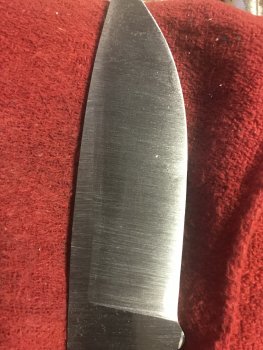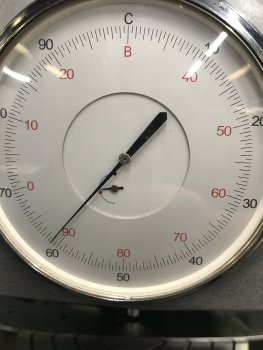tkroenlein
Well-Known Member
I've recently started using Turco, and I'm not sure if I'm solving a problem or making a problem.
In the picture, if you strain your eyes just right, you can see a shadow about 3/16" from the grind line. I believe this is an effect of the migration of whatever is in Turco that occurs during heat treating. It is .008"-.010" deep.
This particular blade is 52100. I double dipped it in Turco, and normalized the blade at 1700F for 20 min, followed by two heats for 30 mins at 1460F with a furnace cool to 1260F on the last cycle.
My intent with this was to set up the blade to need only the final austenitizing heat at 1500F, treated again with Turco, so I can get closer to final grind dimensions. The Turco is effective at limiting decarb, even at 1700F which is over the 1600F limit that it is advertised at.
I'm curious if anyone has experienced this.
In the picture, if you strain your eyes just right, you can see a shadow about 3/16" from the grind line. I believe this is an effect of the migration of whatever is in Turco that occurs during heat treating. It is .008"-.010" deep.
This particular blade is 52100. I double dipped it in Turco, and normalized the blade at 1700F for 20 min, followed by two heats for 30 mins at 1460F with a furnace cool to 1260F on the last cycle.
My intent with this was to set up the blade to need only the final austenitizing heat at 1500F, treated again with Turco, so I can get closer to final grind dimensions. The Turco is effective at limiting decarb, even at 1700F which is over the 1600F limit that it is advertised at.
I'm curious if anyone has experienced this.


